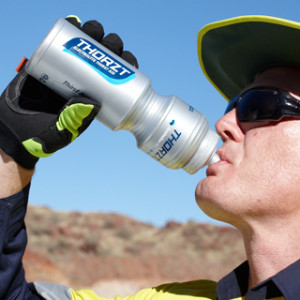
Posted: Wednesday, June 24, 2016 9:30 am
Are You Prepared to Stay Safe Outside This Summer?
Did you know that some football training staffs have their players drink a gallon of a sports drink the afternoon/evening before the big game? You might think that is excessive but in reality it is very smart, especially before games that will be played in a hot climate. Anyone who is going to be outdoors in high heat levels are at risk for a heat related illness. You might think that you should drink more water after you are outside for a period of time in the heat which is true, but in reality you should start hydrating long before you step out the door. To prevent dehydration, you must drink before, during and after being outdoors in the heat.
Thirst is not a good indicator of when to drink fluids. Thirst is a signal the body is already on the way to dehydration. One of the best ways to check your hydration level is to check your urine. It should be plentiful and very pale yellow. If your urine is dark yellow or looks like mountain dew (my interpretation) you are in the first stages of dehydration.
Even slight dehydration can cause symptoms and compromise a person’s ability to work or play safely outdoors. Water is one of the most essential components of the human body. It regulates the body’s temperature protects vital organs, transports nutrients and dispels waste. Over half of the human body is composed of water. So if you are dehydrated all systems are at risk. Most experts agree that ingestion of water should be half of the body’s weight in water per day. There are of course exceptions to this rule of thumb, so discuss this topic with your personal physician if you have any concerns. Also keep in mind that you lose electrolytes (sodium and potassium in sweat). That is why some sports teams choose a sports drink with electrolytes. Low sodium and potassium can lead to dangerous consequences to health. Water is usually the drink of choice for most people as it hydrates the body well, but some activities that require outdoor heat exposure for an extended period of time (and excessive sweating) may warrant electrolyte replacement.
Illnesses related to heat exposure are as follows:
- Heat cramps- caused by more sweating than fluid intake
- Heat exhaustion- dehydration with symptoms such as headache, nausea, confusion, fatigue, paleness, weakness, excessive thirst, clammy skin and profuse sweating
- Heat stroke- The body’s core temperature rises to dangerous levels (104-106), confusion, convulsions, hot dry skin, sweating ceases, and loss of consciousness are symptoms. This is a life-threatening situation. Seek medical help immediately
There are several factors that can affect the body’s reaction to heat.
- Physical activity- The more intense the activity outside the faster the body’s core temperature will rise
- Physical condition- The better the overall physical condition the better the body can regulate heat
- Body mass- If a person is overweight the body tends to heat up quicker and cool down more slowly
- Age- As a person ages, it is more difficult to regulate heat
- Medications- Medicines can affect how the body regulates heat, especially blood pressure meds
- Acclimatization-The more exposure to heat slowly over time, the more the body gets efficient in regulating heat
- Humidity-The higher the humidity the less sweat can evaporate to cool the body
Once again the best way to check your hydration level is to look at your urine. If you are not going to the bathroom for several hours, and or if your urine is dark yellow chances are you are dehydrated. Keep in mind that caffeinated beverages are diuretics and will worsen the problem.
Stay safe out there!
See you in the gym!







It is a good comment to know that you are needing to drink fluids before you feel thirsty. Also the video is good information to know to “be in the clear”!